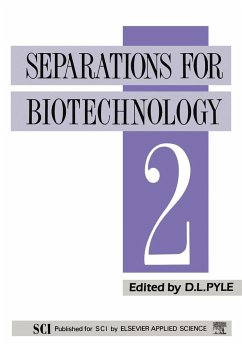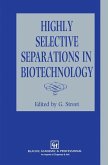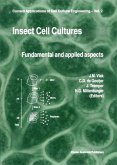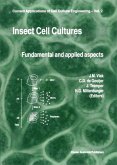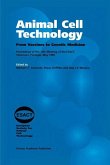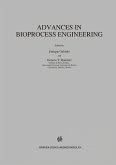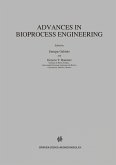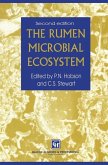- Gebundenes Buch
- Merkliste
- Auf die Merkliste
- Bewerten Bewerten
- Teilen
- Produkt teilen
- Produkterinnerung
- Produkterinnerung
The challenge of bioseparations is to isolate and purify identified products from the dilute product broth produced from cell culture. Innovation in bioseparations technology is increasingly driven by the requirements imposed by the growing importance of production on a process scale of injectable-grade products, and economic pressures to improve the efficiency of downstream processing. As in other areas of technical change, science does not necessarily precede new technology: progress results from a complex and messy mixture of advances in understanding, ingenious ideas, novel techniques and…mehr
Andere Kunden interessierten sich auch für
![Highly Selective Separations in Biotechnology Highly Selective Separations in Biotechnology]() G. Street (Hrsg.)Highly Selective Separations in Biotechnology166,99 €
G. Street (Hrsg.)Highly Selective Separations in Biotechnology166,99 €![Insect Cell Cultures Insect Cell Cultures]() Just M. Vlak / Cornelis D. de Gooijer / Johannes Tramper / Herbert G. Miltenburger (eds.)Insect Cell Cultures249,99 €
Just M. Vlak / Cornelis D. de Gooijer / Johannes Tramper / Herbert G. Miltenburger (eds.)Insect Cell Cultures249,99 €![Insect Cell Cultures Insect Cell Cultures]() Insect Cell Cultures249,99 €
Insect Cell Cultures249,99 €![Animal Cell Technology Animal Cell Technology]() Manuel J.T. Carrondo / Bryan Griffiths / Jos‚ L.P. Moreira (Hgg.)Animal Cell Technology251,99 €
Manuel J.T. Carrondo / Bryan Griffiths / Jos‚ L.P. Moreira (Hgg.)Animal Cell Technology251,99 €![Advances in Bioprocess Engineering Advances in Bioprocess Engineering]() Advances in Bioprocess Engineering221,99 €
Advances in Bioprocess Engineering221,99 €![Advances in Bioprocess Engineering Advances in Bioprocess Engineering]() GalindoAdvances in Bioprocess Engineering251,99 €
GalindoAdvances in Bioprocess Engineering251,99 €![The Rumen Microbial Ecosystem The Rumen Microbial Ecosystem]() The Rumen Microbial Ecosystem221,99 €
The Rumen Microbial Ecosystem221,99 €-
-
-
The challenge of bioseparations is to isolate and purify identified products from the dilute product broth produced from cell culture. Innovation in bioseparations technology is increasingly driven by the requirements imposed by the growing importance of production on a process scale of injectable-grade products, and economic pressures to improve the efficiency of downstream processing. As in other areas of technical change, science does not necessarily precede new technology: progress results from a complex and messy mixture of advances in understanding, ingenious ideas, novel techniques and chance discoveries. What is certain is that close interaction between academics and practitioners, biological scientists and process engineers is needed to solve the problems of bioseparations. The Second International Conference on Separations for Biotechnology at Reading, UK, in September 1990 set out to provide a critical multidisciplinary forum for the discussion of bioseparations. This volume contains the papers presented at the meeting. The meeting was organised around six themes with oral and poster presentations on the science and practice of bioseparations technology, and the same structure has been kept for this book. We have also included the texts of the keynote review paper by Professor Alan Michaels and the introductory review papers specially commissioned for the conference. Within each part of this book the review paper is followed by the contributed papers grouped alphabetically by their first author. All the original papers published here were accepted for publication after scientific refereeing.
Hinweis: Dieser Artikel kann nur an eine deutsche Lieferadresse ausgeliefert werden.
Hinweis: Dieser Artikel kann nur an eine deutsche Lieferadresse ausgeliefert werden.
Produktdetails
- Produktdetails
- Verlag: Springer / Springer Netherlands
- Artikelnr. des Verlages: 978-1-85166-545-7
- 1990.
- Seitenzahl: 658
- Erscheinungstermin: 30. September 1990
- Englisch
- Gewicht: 1290g
- ISBN-13: 9781851665457
- ISBN-10: 1851665455
- Artikelnr.: 26655040
- Herstellerkennzeichnung
- Libri GmbH
- Europaallee 1
- 36244 Bad Hersfeld
- gpsr@libri.de
- Verlag: Springer / Springer Netherlands
- Artikelnr. des Verlages: 978-1-85166-545-7
- 1990.
- Seitenzahl: 658
- Erscheinungstermin: 30. September 1990
- Englisch
- Gewicht: 1290g
- ISBN-13: 9781851665457
- ISBN-10: 1851665455
- Artikelnr.: 26655040
- Herstellerkennzeichnung
- Libri GmbH
- Europaallee 1
- 36244 Bad Hersfeld
- gpsr@libri.de
Plenary Paper.- Frontiers of Bioseparations Technology: Unsolved Problems and Novel Process Concepts.- 1: Cell Disruption and Removal of Insolubles.- Cell Disruption and Removal of Insolubles (Review Paper).- Differential Product Release from Yeast Cells by Selective Enzymatic Lysis.- Conceptual Design of a Novel Flocculation Device.- The Effect of Culture History on the Disruption of Alcaligenes eutrophus by High Pressure Homogenisation.- Separation by Biopolymers: Separation of Suspended Solids by Microbial Flocculant.- Protein Release from the Yeast Pichia pastoris by Chemical Permeabilization: Comparison to Mechanical Disruption and Enzymatic Lysis.- The Concentration of Yeast Suspensions by Crossflow Filtration.- Heterologous Flocculation of Escherichia coli and Yeast.- Lateral Migration: A Laminar Fluid Flow Mechanism Suited to Biotechnology Separations.- The Dewatering of Biological Suspensions in Industrial Centrifuges.- 2: Concentration Processes.- Concentration and Selectivity in Bioseparations (Review Paper).- A Model for Emulsion Liquid Membrane Extraction of Organic Acids.- Vortex Flow Filtration for Ultrafiltration of Protein Solutions.- Membrane Filtration: a priori Predictions of the Ideal Limiting Flux.- Clarification of Tissue Culture Fluid and Cell Lysates Using Biocryl® Bioprocessing Aids.- Economic Fabrication and Utilisation of Agar Composites in Bioselective Recovery in Fixed and Fluidised Beds.- Electromagnetic Separation of Small Particles in the Dielectric Regime.- Reactive Solvent Extraction of Beta-Lactam Antibiotics.- Aqueous Two-Phase Fractionation: Practical Evaluation for Productive Biorecovery.- Urease Immobilized on an Acrylic Carrier for Enzymatic Removal of Urea.- Solid Phases for Immunoaffinity Adsorption.- The Relationship betweenProtein Partition Coefficient and Polymer Concentration in Aqueous Two-Phase Systems.- Protein Fouling and its Implications for Selection of Ultrafiltration Membranes.- Purification by Two-Phase Partitioning of a Hepatitis Core Protein- Pertussis Epitope Fusion, Expressed in Yeast.- Separation of Low-Molecular Organic Compounds from Complex Aqueous Mixtures by Extraction.- Extraction of Citric Acid Using a Supported Liquid Membrane.- 3: High Resolution Separations.- The Future of High Resolution Purification (Review Paper).- Stable Synthetic Affinity Ligands for Use in Protein Fractionation.- The Utility of Polymeric Reversed Phase Packings for the Purification of Peptides, Proteins and Antibiotics.- Batch Stirred Tank Adsorption of Impurity of Cephalosporin C, Desacetylcephalosporin C, Using Modified Amberlite XAD-2 Resin.- Modification of Microfiltration Membranes as Dye-Ligand Adsorbents for the Isolation of Enzymes from Crude Extracts.- Adsorption-Desorption of Proteins in RP-HPLC RNase on C4 Supports.- Affinity Separations Using Microcapsules.- Modelling of Protein Adsorption in Liquid Fluidized Beds.- Affinity Separation of Proteins in Aqueous Two-Phase Systems.- Effect of pH on Polygalacturonase Adsorption in CM-Sephadex Gels.- Purification and Characterisation of Sarcosine Dehydrogenase.- Separation of Some Sulphated Olivanic Acids Using Immobilised Cyclodextrins.- Separation with Porous Glass Membranes and Controlled Pore Glass (CPG) Chromatography.- Performance on Anion-Exchange Cellulose at Process-Scale.- High Speed Analytical and Preparative Separations of Biological Macromolecules.- Purification and Characterisation of Gentamicin Acetyl Transferase.- Affinity Purification Using Radial Streaming Affinity Chromatography.- Multi-component Adsorption of Proteins to Ion Exchangers.- 4: Product Finishing.- The Manufacture of Proteins for Human Therapeutic Use (Review Paper).- Immunoaffinity Purification of Guar Alpha-Galactosidase Using Mild Elution Conditions.- Purification of Mouse IgGl on Protein A and the Measurement of Contaminating Protein A.- Analyses of Purity and Homogeneity in Production Processes.- Purification of Monoclonal Antibodies for Human Clinical Use: Validation of DNA and Retroviral Clearance.- Analysis of Recombinant Human IFN-Gamma Produced in CHO Cells: Effects of Glycosylation and Proteolytic Processing on Product Heterogeneity.- Validation of the Re-use of Protein A Sepharose for the Purification of Monoclonal Antibodies.- Process Design for the Inactivation of Viruses in the Manufacture of Pharmaceutical Proteins.- Investigations of Apparent Homogeneity and Stability of Recombinant HuIFN-Alpha 1.- 5: Integrated Processes.- The Rational Design of Large Scale Protein Separation Processes.- Downstream Processing of Extracellular Enzymes of Aspergillus niger.- Ethanol Production by Extractive Fermentation: A Novel Membrane Extraction Technique.- Continuous Chromatographic Bioreaction-Separation.- Thermodynamic Analysis of Separation Process Alternatives.- Secondary Metabolites by Extractive Fermentation.- Cloning and Expression as a Tool to Easily Purify a New Highly Thermostable Archaebacterial ?-Galactosidase.- 6: Downstream Systems Design and Control.- Downstream Process Design and Bioproduct Quality Control (Review Paper).- Biosafety in Downstream Processing.- Automated Multi-stage Chromatographic Systems for Production of Bio therapeutics.- Applications of Molecular Size Detection in Column Chromatography.- The Monitoring and Control of Protein Purification and Recovery Processes.- A Study ofPermeability and Hydrodynamic Dispersion under Conditions of Chromatographic Flow.- Simple Diagnostic Guidelines for Adsorption Column Performance.- Index of Contributors.
Plenary Paper.- Frontiers of Bioseparations Technology: Unsolved Problems and Novel Process Concepts.- 1: Cell Disruption and Removal of Insolubles.- Cell Disruption and Removal of Insolubles (Review Paper).- Differential Product Release from Yeast Cells by Selective Enzymatic Lysis.- Conceptual Design of a Novel Flocculation Device.- The Effect of Culture History on the Disruption of Alcaligenes eutrophus by High Pressure Homogenisation.- Separation by Biopolymers: Separation of Suspended Solids by Microbial Flocculant.- Protein Release from the Yeast Pichia pastoris by Chemical Permeabilization: Comparison to Mechanical Disruption and Enzymatic Lysis.- The Concentration of Yeast Suspensions by Crossflow Filtration.- Heterologous Flocculation of Escherichia coli and Yeast.- Lateral Migration: A Laminar Fluid Flow Mechanism Suited to Biotechnology Separations.- The Dewatering of Biological Suspensions in Industrial Centrifuges.- 2: Concentration Processes.- Concentration and Selectivity in Bioseparations (Review Paper).- A Model for Emulsion Liquid Membrane Extraction of Organic Acids.- Vortex Flow Filtration for Ultrafiltration of Protein Solutions.- Membrane Filtration: a priori Predictions of the Ideal Limiting Flux.- Clarification of Tissue Culture Fluid and Cell Lysates Using Biocryl® Bioprocessing Aids.- Economic Fabrication and Utilisation of Agar Composites in Bioselective Recovery in Fixed and Fluidised Beds.- Electromagnetic Separation of Small Particles in the Dielectric Regime.- Reactive Solvent Extraction of Beta-Lactam Antibiotics.- Aqueous Two-Phase Fractionation: Practical Evaluation for Productive Biorecovery.- Urease Immobilized on an Acrylic Carrier for Enzymatic Removal of Urea.- Solid Phases for Immunoaffinity Adsorption.- The Relationship betweenProtein Partition Coefficient and Polymer Concentration in Aqueous Two-Phase Systems.- Protein Fouling and its Implications for Selection of Ultrafiltration Membranes.- Purification by Two-Phase Partitioning of a Hepatitis Core Protein- Pertussis Epitope Fusion, Expressed in Yeast.- Separation of Low-Molecular Organic Compounds from Complex Aqueous Mixtures by Extraction.- Extraction of Citric Acid Using a Supported Liquid Membrane.- 3: High Resolution Separations.- The Future of High Resolution Purification (Review Paper).- Stable Synthetic Affinity Ligands for Use in Protein Fractionation.- The Utility of Polymeric Reversed Phase Packings for the Purification of Peptides, Proteins and Antibiotics.- Batch Stirred Tank Adsorption of Impurity of Cephalosporin C, Desacetylcephalosporin C, Using Modified Amberlite XAD-2 Resin.- Modification of Microfiltration Membranes as Dye-Ligand Adsorbents for the Isolation of Enzymes from Crude Extracts.- Adsorption-Desorption of Proteins in RP-HPLC RNase on C4 Supports.- Affinity Separations Using Microcapsules.- Modelling of Protein Adsorption in Liquid Fluidized Beds.- Affinity Separation of Proteins in Aqueous Two-Phase Systems.- Effect of pH on Polygalacturonase Adsorption in CM-Sephadex Gels.- Purification and Characterisation of Sarcosine Dehydrogenase.- Separation of Some Sulphated Olivanic Acids Using Immobilised Cyclodextrins.- Separation with Porous Glass Membranes and Controlled Pore Glass (CPG) Chromatography.- Performance on Anion-Exchange Cellulose at Process-Scale.- High Speed Analytical and Preparative Separations of Biological Macromolecules.- Purification and Characterisation of Gentamicin Acetyl Transferase.- Affinity Purification Using Radial Streaming Affinity Chromatography.- Multi-component Adsorption of Proteins to Ion Exchangers.- 4: Product Finishing.- The Manufacture of Proteins for Human Therapeutic Use (Review Paper).- Immunoaffinity Purification of Guar Alpha-Galactosidase Using Mild Elution Conditions.- Purification of Mouse IgGl on Protein A and the Measurement of Contaminating Protein A.- Analyses of Purity and Homogeneity in Production Processes.- Purification of Monoclonal Antibodies for Human Clinical Use: Validation of DNA and Retroviral Clearance.- Analysis of Recombinant Human IFN-Gamma Produced in CHO Cells: Effects of Glycosylation and Proteolytic Processing on Product Heterogeneity.- Validation of the Re-use of Protein A Sepharose for the Purification of Monoclonal Antibodies.- Process Design for the Inactivation of Viruses in the Manufacture of Pharmaceutical Proteins.- Investigations of Apparent Homogeneity and Stability of Recombinant HuIFN-Alpha 1.- 5: Integrated Processes.- The Rational Design of Large Scale Protein Separation Processes.- Downstream Processing of Extracellular Enzymes of Aspergillus niger.- Ethanol Production by Extractive Fermentation: A Novel Membrane Extraction Technique.- Continuous Chromatographic Bioreaction-Separation.- Thermodynamic Analysis of Separation Process Alternatives.- Secondary Metabolites by Extractive Fermentation.- Cloning and Expression as a Tool to Easily Purify a New Highly Thermostable Archaebacterial ?-Galactosidase.- 6: Downstream Systems Design and Control.- Downstream Process Design and Bioproduct Quality Control (Review Paper).- Biosafety in Downstream Processing.- Automated Multi-stage Chromatographic Systems for Production of Bio therapeutics.- Applications of Molecular Size Detection in Column Chromatography.- The Monitoring and Control of Protein Purification and Recovery Processes.- A Study ofPermeability and Hydrodynamic Dispersion under Conditions of Chromatographic Flow.- Simple Diagnostic Guidelines for Adsorption Column Performance.- Index of Contributors.

